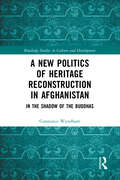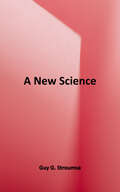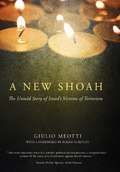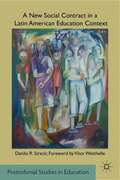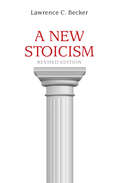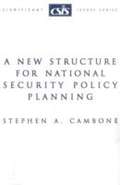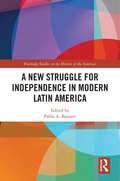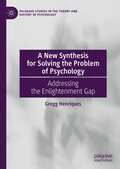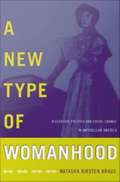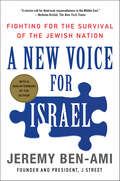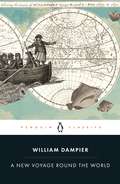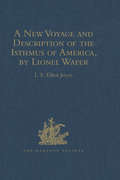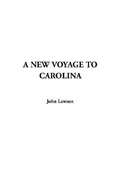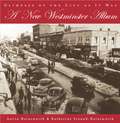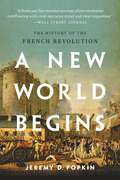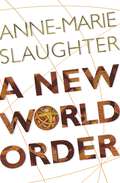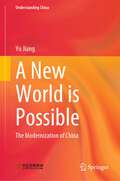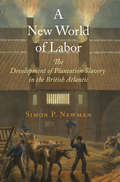- Table View
- List View
A New Politics of Heritage Reconstruction in Afghanistan: In the Shadow of the Buddhas (Routledge Studies in Culture and Development)
by Constance WyndhamA New Politics of Heritage Reconstruction in Afghanistan investigates the politics of cultural heritage preservation in Afghanistan between 2008 and 2015. Based on several periods of ethnographic fieldwork and the author’s direct employment on several internationally-sponsored heritage projects, this book studies the new and complex intersections between cultural heritage and politics in Afghanistan. Wyndham argues that a particular configuration of heritage and politics has emerged after the destruction of the Buddhas at Bamyan and demonstrates how the characteristics of this ‘post-Bamyan’ heritage paradigm are revealed through a number of case studies of internationally sponsored heritage work. These case studies reveal how politics and heritage are currently configured across a diverse range of governments, state and non-state actors, NGOs, individuals and forms of expertise—and why such intersections matter. The book responds to a call from across the discipline of Heritage Studies to look more closely at the relationships between heritage, power and politics. A New Politics of Heritage Reconstruction in Afghanistan provides a fascinating case study on the intersection of heritage and politics that will be of interest to students and scholars of heritage, as well as to professionals working on heritage preservation - both within and outside of government.
A New Reformation: Creation Spirituality and the Transformation of Christianity
by Matthew FoxA modern-day theologian’s call for the radical transformation of Christianity• Echoes the Reformation initiated by Martin Luther in 1517• Addresses the corruption and authoritarian tendencies that distinguish today’s Christian institutions from the spiritual message upon which they are founded• Offers a new vision of Christianity that values the Earth, honors the feminine, and emphasizes spiritual toleranceIn 1517, Martin Luther, disgusted at the corruption then reigning in the Catholic Church, nailed on the door of Castle Church in Wittenberg, Germany, 95 theses calling for a Reformation. During Pentecost week 2005, former Dominican priest Matthew Fox nailed at that same church door a new set of 95 theses calling for a reawakening of the Christian spirit and a repudiation of the authoritarian, punitive tendencies that prevail in modern churches today. Fox’s theses not only condemn the deep corruption in the hierarchy of the Roman Catholic Church, made evident by the pedophile scandal and the recent canonization of a fascist admirer of Hitler, but also speak to the loss of inspiration and resulting apathy that have emptied churches of all denominations.Fox says, “At this critical time in human and planetary history, when the earth is being ravaged by the violence of war, poverty, sexism, homophobia, and eco-destruction, we need to gather those who offer a future that is one of compassion, creativity, and justice to speak their conscience as never before. Religion ought to be part of the solution, not the problem.” His 95 theses call for a New Reformation, a radical transformation that will allow us to move once again from the hollow trappings of organized religion to genuine spirituality.
A New Religious America: How a "Christian Country" Has Become the World's Most Religiously Diverse Nation
by Diana L. EckWhy Understanding America's Religious Landscape Is the Most Important Challenge Facing Us TodayThe 1990s saw the U.S. Navy commission its first Muslim chaplain and open its first mosque.There are presently more than three hundred temples in Los Angeles, home to the greatest variety of Buddhists in the world.There are more American Muslims than there are American Episcopalians, Jews, or Presbyterians.
A New Religious America: How a Christian Country Has Become the World's Most Religiously Diverse Nation
by Diana L. EckThis exploration of the new religious landscape of America by a leading world religions professor traces the history of freedom of religion in the United States and highlights the challenges posed by intolerance and hatred. Newly revised and updated.
A New Science: The Discovery of Religion in the Age of Reason
by Guy G. StroumsaWe see the word “religion” everywhere, yet do we understand what it means, and is there a consistent worldwide understanding? Who discovered religion and in what context? <p><p>In A New Science, Guy Stroumsa offers an innovative and powerful argument that the comparative study of religion finds its origin in early modern Europe. The world in which this new category emerged was marked by three major historical and intellectual phenomena: the rise of European empires, that gave birth to ethnological curiosity; the Reformation, which permanently altered Christianity; and the invention of philology, a discipline that transformed Western intellectual thought. Against this complex historical backdrop, Stroumsa guides us through the lives and writings of the men who came to define the word “religion.” <p><p>As Stroumsa boldly argues, the modern study of religion, a new science, was made possible through a dialectical process between Catholic and Protestant scholars. Ancient Israelite religion, Judaism, Christianity, Islam, Manichaeanism, Zoroastrianism, the sacred beliefs of the New World, and those of Greece, Rome, India, and China, composed the complex ground upon which “religion,” a most modern category, was discovered.
A New Shoah
by Giulio MeottiEvery day in Israel, memorials are being held for the victims of Islamic fundamentalism. Since the "Second Intifada" began ten years ago, Palestinian terrorists have claimed 1,700 Israeli civilians. This equates to a staggering 70,000 victims, when adjusted to the United States population for scale.In A New Shoah, Italian journalist Giulio Meotti's extensive interviews with those Israeli families torn apart by hundreds of daily attacks in buses, cafés, kibbutzim, restaurants, night clubs, and religious shrines appear for the first time. A New Shoah reveals the stories, ideals, and faces behind the statistics, from the anticommunist dissidents who fled Moscow, to the American businessman who left everything behind to live the dream of Jewish pioneers.The remarkable individuals who make up A New Shoah reveal the raison d'être of the State of Israel and make a definitive case for its safeguarding. Judaism teaches that for survivors, the hazkarah, or the act of remembering, is the only way to defy the murder of Jewish people by their enemies. When we read these pages and remember, we empower Israel's resistance to terror.
A New Social Contract in a Latin American Education Context
by Danilo R. StreckA New Social Contract in a Latin American Education Context is committed to what has become known as "perspective of the South:" understanding the South not as a geographical reference but as a vindication of the existence of ways of knowing and of living which struggle for their survival and for a legitimate place in a world where the respect for difference is balanced with the right for equality. The metaphor of the new social contract stands for the desire to envision another world, which paradoxically cannot but spring out of the entrails of the existing one. Could the same contract under which the colonial orders were erected serve as a tool for decolonizing relations, knowledge, and power? Consequently, what kind of education could effectively help structure a new social contract? These are some of the questions Streck addresses.
A New Stoicism
by Lawrence C. BeckerWhat would stoic ethics be like today if stoicism had survived as a systematic approach to ethical theory, if it had coped successfully with the challenges of modern philosophy and experimental science? A New Stoicism proposes an answer to that question, offered from within the stoic tradition but without the metaphysical and psychological assumptions that modern philosophy and science have abandoned. Lawrence Becker argues that a secular version of the stoic ethical project, based on contemporary cosmology and developmental psychology, provides the basis for a sophisticated form of ethical naturalism, in which virtually all the hard doctrines of the ancient Stoics can be clearly restated and defended. Becker argues, in keeping with the ancients, that virtue is one thing, not many; that it, and not happiness, is the proper end of all activity; that it alone is good, all other things being merely rank-ordered relative to each other for the sake of the good; and that virtue is sufficient for happiness. Moreover, he rejects the popular caricature of the stoic as a grave figure, emotionally detached and capable mainly of endurance, resignation, and coping with pain. To the contrary, he holds that while stoic sages are able to endure the extremes of human suffering, they do not have to sacrifice joy to have that ability, and he seeks to turn our attention from the familiar, therapeutic part of stoic moral training to a reconsideration of its theoretical foundations.
A New Structure for National Security Policy Planning
by Stephen A. Cambone Patrick J. Carrity Alistair J. K. ShepherdThis book draws a contrast between the pre and post Cold War era, provides an insight into intellectual and operational frameworks, and suggests changes that can be made today as well as to foster further debate.
A New Struggle for Independence in Modern Latin America
by Pablo A. BaisottiThis volume explores several notable themes related to foreign affairs in Latin America and the reconfiguration of the power of the different states in the region. It offers insightful historical perspectives for understanding national, regional and global issues from the beginning of the 20th century to the present day, from analysis of the traditional "hegemony" of the United States over Latin America through its military, and political influence due to the presence of the European Union, Russia, and China. These views cannot be reduced to a simplistic vision of the dominant and subordinate; rather, they attempt to seek lines of continuity by highlighting traditional interpretations of new scenarios such as regional trading and security blocs. The volume refuses to impose a traditional and uncritical linear historical narrative onto the reader and instead proposes an alternative interpretation of the past and its relation to the present. Finally, the growing importance of international mechanisms in enabling the success of certain Latin American regimes is also highlighted, in particular the influence of regional diffusion through international organizations or other networks.
A New Synthesis for Solving the Problem of Psychology: Addressing the Enlightenment Gap (Palgrave Studies in the Theory and History of Psychology)
by Gregg HenriquesIn this incisive analysis of academic psychology, Gregg Henriques examines the fragmented nature of the discipline and explains why the field has had enormous difficulty specifying its subject matter and how this has limited its ability to advance our knowledge of the human condition. He traces the origins of the problem of psychology to a deep and profound gap in our knowledge systems that emerged in the context of the scientific Enlightenment.To address this problem, this book introduces a new vision for scientific psychology called mental behaviorism. The approach is anchored to a comprehensive metapsychological framework that integrates insights from physics and cosmic evolution, neuroscience, the cognitive and behavioral sciences, developmental and complex adaptive systems theory, attachment theory, phenomenology, and social constructionist perspectives and is well grounded in the philosophy of science. Building on more than twenty years of work in theoretical psychology and drawing on a wide range of literature, Professor Henriques shows how this new approach to scientific knowledge fills in the gaps of our current understanding of psychology and can allow us to develop a more holistic and sophisticated way to understand animal and human mental behavioral patterns. This work will especially appeal to students and scholars of general psychology and theoretical psychology, as well as to historians and philosophers of science.
A New Type of Womanhood: Discursive Politics and Social Change in Antebellum America
by Natasha Kirsten KrausIn A New Type of Womanhood, Natasha Kirsten Kraus retells the history of the 1850s woman's rights movement. She traces how the movement changed society's very conception of "womanhood" in its successful bid for economic rights and rights of contract for married women. Kraus demonstrates that this discursive change was a necessary condition of possibility for U. S. women to be popularly conceived as civil subjects within a Western democracy, and she shows that many rights, including suffrage, followed from the basic right to form legal contracts. She analyzes this new conception of women as legitimate economic actors in relation to antebellum economic and demographic changes as well as changes in the legal structure and social meanings of contract. Enabling Kraus's retelling of the 1850s woman's rights movement is her theory of "structural aporias," which takes the institutional structures of any particular society as fully imbricated with the force of language. Kraus reads the antebellum relations of womanhood, contract, property, the economy, and the nation as a fruitful site for analysis of the interconnected power of language, culture, and the law. She combines poststructural theory, particularly deconstructive approaches to discourse analysis; the political economic history of the antebellum era; and the interpretation of archival documents, including woman's rights speeches, petitions, pamphlets, and convention proceedings, as well as state legislative debates, reports, and constitutional convention proceedings. Arguing that her method provides critical insight not only into social movements and cultural changes of the past but also of the present and future, Kraus concludes A New Type of Womanhood by considering the implications of her theory for contemporary feminist and queer politics.
A New Voice for Israel: Fighting for the Survival of the Jewish Nation
by Jeremy Ben-AmiMany Americans who care about Israel's future are questioning whether the hard-line, uncritical stances adopted by many traditional pro-Israel advocates really serve the country's best interests over the long-term. Moderate Jeremy Ben-Ami, founder of J Street, the new pro-Israel, pro-peace political movement, punctures many of the myths that have long guided our understanding of the politics of the American Jewish community and have been fundamental to how pro-Israel advocates have pursued their work. These myths include:- that leaders of established Jewish organizations speak for all Jewish Americans when it comes to Israel- that being pro-Israel means you cannot support creation of a Palestinian state - that American Jews vote for candidates based largely on their support of Israel - that talking peace with your enemies demonstrates weakness - that allying with neoconservatives and evangelical Christians is good for Israel and good for the Jewish community. Ben-Ami, whose grandparents were first-generation Zionists and founders of Tel Aviv, tells the story of his own evolution toward a more moderate viewpoint. He sketches a new direction for both American policy and the conduct of the debate over Israel in the American Jewish community.
A New Voyage Round the World
by William Dampier'A roaring tale ... remains as vivid and exciting today as it was on publication in 1697' GuardianThe pirate and adventurer William Dampier circumnavigated the globe three times, and took notes wherever he went. This is his frank, vivid account of his buccaneering sea voyages around the world, from the Caribbean to the Pacific and East Indies. Filled with accounts of raids, escapes, wrecks and storms, it also contains precise observations of people, places, animals and food (including the first English accounts of guacamole, mango chutney and chopsticks). A bestseller on publication, this unique record of the colonial age influenced Robinson Crusoe, Gulliver's Travels and consequently the whole of English literature.Edited with an Introduction by Nicholas Thomas
A New Voyage and Description of the Isthmus of America, by Lionel Wafer: Surgeon on Buccaneering Expeditions in Darien, the West Indies, and the Pacific, from 1680 to 1688. With Wafer's Secret Report (1698), and Davis's Expedition to the Gold Mines (1704) (Hakluyt Society, Second Series)
by L. E. Elliot JoyceThe text of the 1699 edition, with slight changes, and additional material, edited with introduction, notes and appendices. This is a new print-on-demand hardback edition of the volume first published in 1934.
A New Voyage to Carolina
by John LawsonJohn Lawson's amazingly detailed yet lively book is easily one of the most valuable of the early histories of the Carolinas, and it is certainly one of the best travel accounts of the early eighteenth-century colonies. An inclusive account of the manners and customs of the Indian tribes of that day, it is also a minute report of the soil, climate, trees, plants, animals, and fish in the Carolinas.Lawson's observation is keen and thorough; his style direct and vivid. He misses nothing and recounts all -- from the storms at sea to his impressions of New York in 1700, the trip down the coast to Charleston, and his travels from there into North Carolina with his Indian guides.The first edition of this work was published in London in 1709. While various editions followed in the eighteenth century -- including two in German -- this edition is a true copy of the original and is the first to include a comprehensive index. It also contains "The Second Charter," "An Abstract of the Constitution of Carolina," Lawson's will, and several previously unpublished letters written by Lawson. A number of DeBry woodcuts of John White's drawings of Indian life, sketches of the beasts of Carolina which appeared in the original 1709 edition, and Lawson's map contribute additional interest to this volume.
A New Way of Seeing: Distance and Traumatic Memory in the Poetry of World War II (American Wars and Popular Culture)
by Michael SarnowskiA New Way of Seeing considers the poetry of five writers—Louis Simpson, Keith Douglas, Richard Hugo, Howard Nemerov, and Randall Jarrell—whose work draws on their activities as soldiers in World War II. Basing his examination on extensive primary-source research, Michael Sarnowski identifies distance, both literal and figurative, and traumatic memory as two interconnected elements of how these poets internalized the war and made sense of the events they witnessed. The book is structured on a gradient related to each poet’s proximity to combat, as the chapters in turn focus on an infantryman (Simpson), a tank commander (Douglas), a bombardier (Hugo), a pilot (Nemerov), and a stateside flight instructor (Jarrell). Sarnowski relies on a wealth of archival material overlooked by previous scholarship, including poem drafts, correspondence, flight logs, and personal belongings. The conclusion revisits notions of legacy and representation by assessing factors that contributed to the early labeling of World War II soldiers as a “Silent Generation,” in contrast to the outpouring of poetry published during and following the First World War. By exploring how poets processed their wartime experiences, A New Way of Seeing offers a stark reminder of why it remains vital to recognize the physical, mental, and psychological consequences endured by veterans.
A New Westminster Album: Glimpses of the City As It Was
by Gavin Hainsworth Katherine Freund-HainsworthFrom prospectors to politicians, promoters to profiteers, New Westminster’s known them all. It is Western Canada’s oldest city, aptly named by Queen Victoria as the first capital of the new colony of British Columbia. On the mighty Fraser River, it has survived gold rushes, loss of capital status, fire, flood, the Depression, and two world wars. This collection of illuminating black and white photographs, artwork, and text shows how its tenacious citizens have thrived. It follows the city’s festivals, traditions, organizations, people, and neighbourhoods. The city has both witnessed and been the centre of the fascinating events that shaped B.C. This multifaceted photographic history album depicts almost 150 years of the City of New Westminster.
A New Working Class: The Legacies of Public-Sector Employment in the Civil Rights Movement (Politics and Culture in Modern America)
by Jane BergerFor decades, civil rights activists fought against employment discrimination and for a greater role for African Americans in municipal decision-making. As their influence in city halls across the country increased, activists took advantage of the Great Society—and the government jobs it created on the local level—to advance their goals.A New Working Class traces efforts by Black public-sector workers and their unions to fight for racial and economic justice in Baltimore. The public sector became a critical job niche for Black workers, especially women, a largely unheralded achievement of the civil rights movement. A vocal contingent of Black public-sector workers pursued the activists' goals from their government posts and sought to increase and improve public services. They also fought for their rights as workers and won union representation. During an era often associated with deindustrialization and union decline, Black government workers and their unions were just getting started.During the 1970s and 1980s, presidents from both political parties pursued policies that imperiled these gains. Fighting funding reductions, public-sector workers and their unions defended the principle that the government has a responsibility to provide for the well-being of its residents. Federal officials justified their austerity policies, the weakening of the welfare state and strengthening of the carceral state, by criminalizing Black urban residents—including government workers and their unions. Meanwhile, workers and their unions also faced off against predominately white local officials, who responded to austerity pressures by cutting government jobs and services while simultaneously offering tax incentives to businesses and investing in low-wage, service-sector jobs. The combination of federal and local policies increased insecurity in hyper-segregated and increasingly over-policed low-income Black neighborhoods, leaving residents, particularly women, to provide themselves or do without services that public-sector workers had fought to provide.
A New World Begins: The History of the French Revolution
by Jeremy PopkinFrom an award-winning historian, a magisterial account of the revolution that created the modern worldThe principles of the French Revolution remain the only possible basis for a just society -- even if, after more than two hundred years, they are more contested than ever before. In A New World Begins, Jeremy D. Popkin offers a riveting account of the revolution that puts the reader in the thick of the debates and the violence that led to the overthrow of the monarchy and the establishment of a new society. We meet Mirabeau, Robespierre, and Danton, in all of their brilliance and vengefulness; we witness the failed escape and execution of Louis XVI; we see women demanding equal rights and black slaves wresting freedom from revolutionaries who hesitated to act on their own principles; and we follow the rise of Napoleon out of the ashes of the Reign of Terror. Based on decades of scholarship, A New World Begins will stand as the definitive treatment of the French Revolution.
A New World Order
by Anne-Marie SlaughterGlobal governance is here--but not where most people think. This book presents the far-reaching argument that not only should we have a new world order but that we already do. Anne-Marie Slaughter asks us to completely rethink how we view the political world. It's not a collection of nation states that communicate through presidents, prime ministers, foreign ministers, and the United Nations. Nor is it a clique of NGOs. It is governance through a complex global web of "government networks." Slaughter provides the most compelling and authoritative description to date of a world in which government officials--police investigators, financial regulators, even judges and legislators--exchange information and coordinate activity across national borders to tackle crime, terrorism, and the routine daily grind of international interactions. National and international judges and regulators can also work closely together to enforce international agreements more effectively than ever before. These networks, which can range from a group of constitutional judges exchanging opinions across borders to more established organizations such as the G8 or the International Association of Insurance Supervisors, make things happen--and they frequently make good things happen. But they are underappreciated and, worse, underused to address the challenges facing the world today. The modern political world, then, consists of states whose component parts are fast becoming as important as their central leadership. Slaughter not only describes these networks but also sets forth a blueprint for how they can better the world. Despite questions of democratic accountability, this new world order is not one in which some "world government" enforces global dictates. The governments we already have at home are our best hope for tackling the problems we face abroad, in a networked world order.
A New World is Possible: The Modernization of China (Understanding China)
by Yu JiangThis book gives a panoramic review of China's 70 years of modernization, reveals the historical process and logic of the formation of the modernization path with Chinese characteristics, especially focuses on the key decision-making process in the history of China's modernization, theoretically compares the Chinese model and the western mainstream model and summarizes the characteristics and experience of China's development model. At the same time, it reveals the causes of the global crisis from a historical perspective and puts forward the future of China based on historical experience. The book tries to answer the following hot-debating questions: What is the core of Chinese experience? Is China model a new model of modernization? Is China's model sustainable? Is this model compatible with the mainstream model? What is the relationship between China's revolution and modernization? How will China's development affect the world? This book will be found helpful by all scholars, students and the public who are interested in China's development path.
A New World of Animals: Early Modern Europeans on the Creatures of Iberian America
by Miguel de Asúa Roger FrenchMany Early Modern Europeans who during the sixteenth and seventeenth centuries travelled to the New World left written or pictorial records of their encounters with a surprising fauna. The story told in this book is woven out of the threads of those texts and pictures. A New World of Animals shows how the initial wonder at the new beasts gave way to a more utilitarian approach, assessing their economic and medical potential. It elucidates how shifts in European perceptions brought the animals from the realm of the fantastic into the mainstream of early modern natural history, while at the same time changing the way in which Europeans saw their own world. Indeed, the chronicles and treatises of those who in the wake of the discovery arrived in the new lands tell as much about the particular interests and mental worlds of the writers as about the 'new animals'. This book traces the amazement of the first explorers and colonizers, the chronicles of soldiers and Indians, the 'natural histories of the New World', the place of animals in the network of economic interests driving the early expansion of Europe, the views of the missionaries and those of natural philosophers and physicians. Taking the reader from the Brazilian forests to the erudite cabinets of the Old World, from Patagonia to the centres of empire, the story of the discovery of the unexpected menagerie of the New World is also an exploration of Early Modern European imagination and learning.
A New World of Hope
by Don HanleyA history professor from the 22nd century seeks to escape his present by traveling to the 21st century to better understand what happened that set the United States of America on a very different course. Mark Haloran is a history professor living in the 22nd century with nothing to lose. This makes him the perfect candidate to test out the new time machine his friend Sam Shafer thinks he has finally perfected. Mark travels back to the year 2019, hoping to connect with his great-great-great-great-parents, high conscious thinkers who he hopes will believe his story and help him with his hands-on research. His goal: to find out what happened following the 2016 presidential election that changed the course of humanity forever. When Mark’s plan for a short vacation to the past is unexpectedly extended, he gets to work, with the help of his family, to give the 21st century a taste of the future.
A New World of Labor
by Simon P. NewmanThe small and remote island of Barbados seems an unlikely location for the epochal change in labor that overwhelmed it and much of British America in the seventeenth and eighteenth centuries. However, by 1650 it had become the greatest wealth-producing area in the English-speaking world, the center of an exchange of people and goods between the British Isles, the Gold Coast of West Africa, and the New World. By the early seventeenth century, more than half a million enslaved men, women, and children had been transported to the island. In A New World of Labor, Simon P. Newman argues that this exchange stimulated an entirely new system of bound labor.Free and bound labor were defined and experienced by Britons and Africans across the British Atlantic world in quite different ways. Connecting social developments in seventeenth-century Britain with the British experience of slavery on the West African coast, Newman demonstrates that the brutal white servant regime, rather than the West African institution of slavery, provided the most significant foundation for the violent system of racialized black slavery that developed in Barbados. Class as much as race informed the creation of plantation slavery in Barbados and throughout British America. Enslaved Africans in Barbados were deployed in radically new ways in order to cultivate, process, and manufacture sugar on single, integrated plantations. This Barbadian system informed the development of racial slavery on Jamaica and other Caribbean islands, as well as in South Carolina and then the Deep South of mainland British North America. Drawing on British and West African precedents, and then radically reshaping them, Barbados planters invented a new world of labor.
